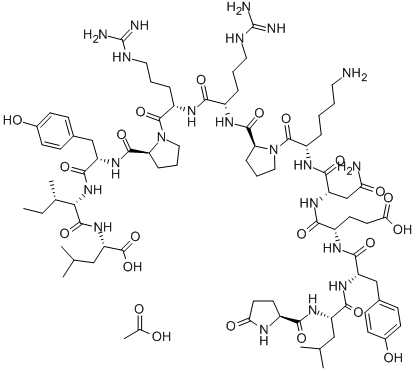Neurotensin has been used as an external calibration reagent in spectrum calibration. It has also been used to evaluate the performance of online capillary electrophoresis to matrix-assisted laser desorption ionization (CE-MALDI).
ChEBI: Neurotensin is a 13 amino acid peptide hormone which is found in the central nervous system and the gastrointestinal tract. It behaves as a neurotransmitter in the brain, as a hormone in the gut, and also as a neuromodulator. It is implicated in the pathophysiology of several CNS disorders (including schizophrenia, Parkinson's disease, drug abuse, pain, cancer, inflammation, eating disorders and central control of blood pressure) due to its association with a wide variety of neurotransmitter systems such as dopaminergic, sertonergic, glutamatergic, GABAergic, and cholinergic systems. It has a role as a human metabolite, a mitogen, a neurotransmitter and a vulnerary. It is a conjugate base of a neurotensin(1+).
Neurotensin (NT) is encoded by the gene mapped to human chromosome 12q21.31. The encoded protein is a tridecapeptide with pGlu–Leu–Tyr–Glu–Asn–Lys–Pro–Arg–Arg–Pro–Tyr–Ile–Leu–COOH amino acid sequence. NT is widely distributed in the gastrointestinal (GI) tract and central nervous system (CNS), but at high levels in hypothalamus, amygdala and nucleus accumbens as well as at low levels in peripheral blood.
Neurotensin (NT) acts as an inducer for analgesia, hypothermia and hyperglycemia, and is an inhibitor of gastric motility. Plasma NT levels are high in children with Prader–Willi syndrome (PWS). NT secreted from small cell lung cancer cells might have a regulatory action in this disease. It has been implicated in regulation of gastric system and inflammatory processes in the lung. In addition, NT also regulates immune response by stimulating cytokine release and chemotaxis on interaction with leukocytes, peritoneal mast cells and dendritic cells. NT present in gastrointestinal (GI) tract plays a vital role in various processes such as stimulation of pancreatic and biliary secretion and enhances growth of various normal tissues. It is involved downstream of Wnt/β-catenin signaling pathway and stimulates the growth of neuroendocrine tumor cells.

